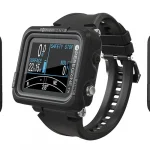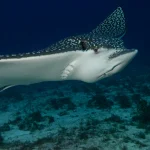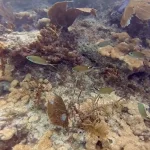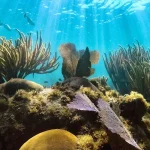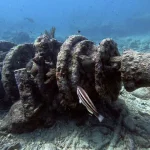Table of Contents
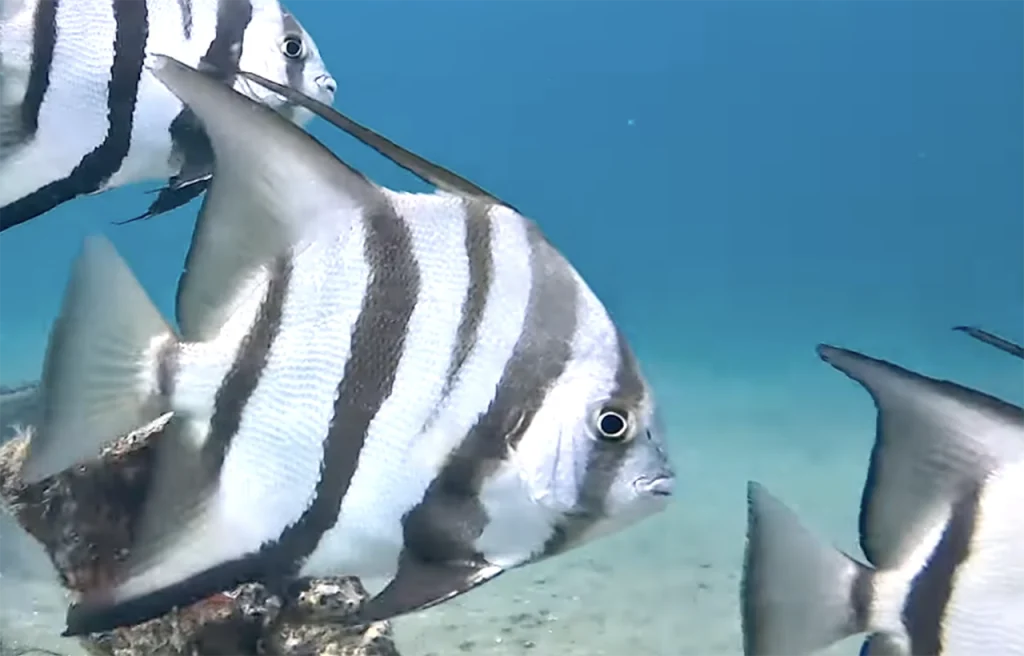
Worth Avenue Pier Debris is a popular shore diving and snorkeling site located in Palm Beach, Florida2. This site offers an excellent opportunity for divers and snorkelers to explore the remains of an old pier, which now serves as an artificial reef teeming with marine life.
Article at a Glance
- Location: A popular shore dive site in Palm Beach, Florida, featuring the remnants of a historic pier destroyed in the 1960s, now serving as an artificial reef.
- Depth Range: Shallow dive between 10 to 20 feet (3 to 6 meters), ideal for beginners and enjoyable for experienced divers seeking a relaxed dive.
- Marine Life: Home to diverse species such as tropical fish, southern stingrays, lobsters, tarpon, and occasional barracuda, making it a vibrant ecosystem.
- Accessibility: Easily accessible from the beach; the debris field begins approximately 100 yards offshore, directly in line with the Worth Avenue clock tower.
- Best Time to Dive: During calm seas and morning hours for optimal visibility and lighting. Summer months are ideal for warmer water and active marine life.
- Photography Opportunities: Perfect for underwater photographers, with colorful marine life, interesting debris structures, and excellent natural lighting in shallow waters.
- Safety Tips: Always use a dive flag to alert boaters, check tide charts for favorable conditions, and avoid diving during rough surf or stormy weather.
Worth Avenue Pier Debris Palm Beach
Location and Access
The debris from the old pier is spread across the ocean floor in a west to east direction, directly in line with the Worth Avenue street sign. The site is accessible from the beach, with the debris starting approximately 100 yards offshore and continuing towards the first reef line.
Depth and Conditions
The depth at Worth Avenue Pier Debris ranges from 8 to 20 feet maximum. The site features very low relief, making it suitable for both novice and experienced divers. It’s best to dive this site when the seas are calm, as it provides optimal conditions for exploration and visibility.
Marine Life
The debris attracts a variety of marine life, making it an exciting dive spot:
- Tropical fish: The site is home to numerous juvenile tropical fish species.
- Sea turtles: Frequently spotted swimming through the area, especially during summer months.
- Lobsters: Can be found hiding among the rocks.
Diving Experience
The Worth Avenue Pier Debris offers a unique diving experience:
- Easy shore dive: Suitable for divers of various skill levels.
- Artificial reef: The pier remains create an interesting underwater landscape to explore.
- Photography opportunities: The abundance of marine life makes it an excellent spot for underwater photography.
What Marine Life Can I Expect To See?
- Fish Species:
- Angelfish
- Butterflyfish
- Damselfish
- Grunts
- Hogfish
- Porcupinefish
- Sergeant Majors
- Snappers
- Tarpon
- Triggerfish
- Other Marine Creatures:
- Southern Stingrays: Commonly seen gliding along the sandy bottom.
- Lobsters: Often found hiding in crevices among the debris.
- Mantis Shrimp: Known for their vibrant colors and powerful claws.
- Barracuda: Occasionally spotted, adding excitement to dives.
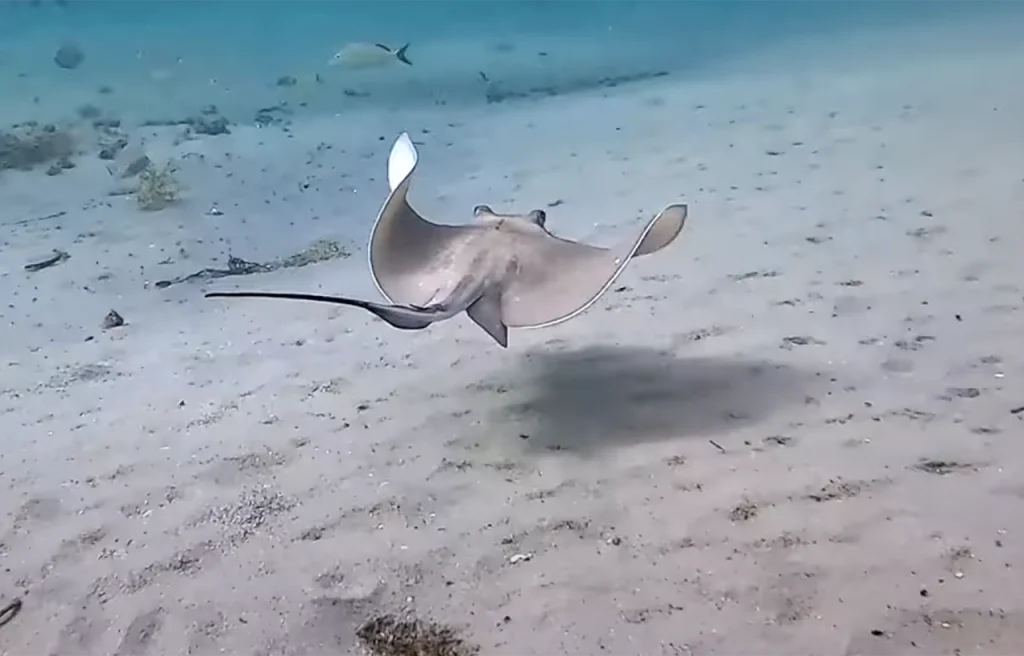
What Do Divers Say About This Site?
General Impressions
- Accessibility: Many divers note that it is an easy shore dive, making it suitable for beginners. The debris field starts about 100 yards offshore, and divers can enter from the beach near the Worth Avenue street sign.
- Visibility and Conditions: Divers have reported varying visibility conditions, often depending on the weather. Some experienced poor visibility due to surf conditions, while others enjoyed clear waters with good visibility, particularly on calmer days.
Marine Life
- Abundance of Species: The site is praised for its rich marine life. Divers frequently encounter a variety of tropical fish, including angelfish, butterflyfish, and grunts, as well as larger species like tarpon and barracuda. Lobsters and stingrays are also commonly spotted.
- Photography Opportunities: Many divers highlight the site as a photographer’s dream, noting the vibrant colors and diversity of marine creatures that can be captured on camera.
Specific Experiences
- Mixed Reviews: Some divers reported challenges finding the debris or navigating through rough surf, leading to disappointment. However, those who visited on calmer days often found the site rewarding with plenty of marine activity.
- Unique Features: The remnants of the old pier create interesting underwater structures that attract fish and other marine life. Divers have described the area as having a “prolific community” of sea life, making it a unique dive experience compared to other sites.
Key Information
| Feature | Details |
|---|---|
| Location | Worth Avenue, Palm Beach, Florida |
| Depth Range | 10 to 20 feet (3 to 6 meters) |
| Visibility | 18 to 30 meters (60 to 100 feet) |
| Experience Level | Suitable for beginners and advanced divers |
| Access | Shore dive; approximately 100 yards offshore |
| Marine Life | Tropical fish, lobsters, tarpon, stingrays, barracuda |
| Best Time to Dive | Calm seas and morning hours |
| Safety Considerations | Use a dive flag; check weather and tide conditions |
| Photography Opportunities | Excellent for underwater photography |
| Historical Significance | Remnants of an old pier, creating an artificial reef |
Highlights of Diving This Site?
- Historical Significance: The site features the remains of the Worth Avenue Pier, originally opened in 1925 and destroyed by storms in the 1960s. This history adds an intriguing element to the dive, as the remnants now serve as an artificial reef.
- Depth and Accessibility: The dive site ranges from 10 to 20 feet deep, making it accessible for divers of all skill levels, including beginners. The easy shore access allows for a straightforward entry into the water.
- Rich Marine Life: Divers can expect to see a variety of marine species, including:
- Tropical Fish: Angelfish, butterflyfish, grunts, and tarpon are commonly spotted.
- Invertebrates: Lobsters, mantis shrimp, and crabs inhabit the area.
- Other Wildlife: Southern stingrays and occasional sea turtles enhance the underwater experience.
- Unique Underwater Features: The debris field consists of scattered pier remnants and natural ledges that create interesting topography for exploration. These structures provide shelter for various marine species, making it a vibrant ecosystem.
- Photography Opportunities: The colorful marine life and unique underwater landscape make this site ideal for underwater photography. Many divers capture stunning images of the diverse species and scenic views.
- Safety Considerations: It is recommended to use a dive flag while diving or snorkeling to ensure safety and visibility to boaters in the area.
My Favorite Dive Computers
I have compared the 3 top diving computers for each category to help making the right choice easier:
Iconic Spots At This Site
- The Debris Field: The main attraction is the extensive debris field from the old pier, which is located about 100 yards offshore. This area is rich with marine life and features various structures that create a habitat for fish and other sea creatures.
- Bowl-Shaped Ledges: Surrounding the debris field, divers can find several bowl-shaped ledges to the north and south. These ledges provide excellent hiding spots for lobsters and other marine life, making them a popular spot for divers looking to observe or photograph wildlife.
- The Clock Tower: While not underwater, the Worth Avenue clock tower serves as a recognizable landmark for divers entering the water. It helps orient divers as they swim out to the debris site, marking the beginning of their underwater adventure.
- Marine Life Hotspots: Throughout the dive, divers can expect to encounter various species such as:
- Southern Stingrays
- Tarpon
- Barracuda
- Porcupine Fish
- Grunts
- Historical Context: Understanding the history of the pier adds depth to the dive experience. Originally opened in 1925 and destroyed by storms over the decades, the remnants now serve as an artificial reef, attracting diverse marine life.
Environmental Conservation Efforts at Worth Avenue Pier Debris
Artificial Reef Program
Palm Beach County’s Department of Environmental Resources Management (ERM) has been actively creating artificial reefs since 1985. This program has deployed:
- Over 55 vessels
- 100,000 tons of concrete
- 133,000 tons of limestone boulders
These artificial reefs span from Tequesta to Boca Raton, creating habitats for marine life and supporting the local ecosystem (4).
Marine Debris Removal
Loggerhead Marinelife Center (LMC) leads several initiatives to combat marine debris:
- Tour de Trash: An annual event that removes debris from beaches and underwater sites. In 2021, it removed over 1,000 pounds of debris across 12 cleanups (1).
- Regular Cleanups: LMC conducts monthly beach and underwater cleanups. In October 2018, they removed 12,923 pieces of trash from beaches (2).
- Data Collection: After each cleanup, LMC sorts and documents every piece of debris to identify major types and sources of pollution (2).
Public Awareness
- LMC unveiled a Marine Debris Sorting Station to educate visitors about the plastic pollution problem in the ocean (2).
- The center promotes initiatives like #NoStrawNovember to encourage the public to reduce single-use plastic consumption (3).
Economic Impact
The artificial reefs in Palm Beach County, including sites like Worth Avenue Pier Debris, generate over $280 million annually and support approximately 3,000 jobs.
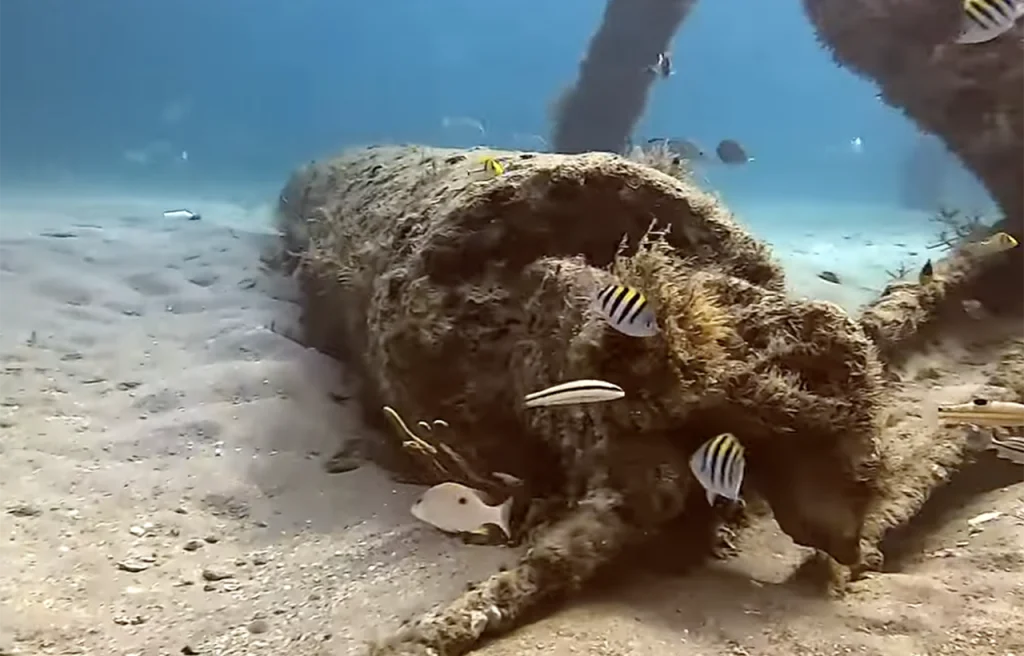
Maximizing Your Diving Experience at Worth Avenue Pier Debris
Timing and Conditions
- Best Time to Dive: Choose calm sea days for optimal visibility and easier entry.
- Tide Considerations: Check local tide charts to plan your dive during favorable conditions.
Navigation and Exploration
- Entry Point: Enter the water in front of the Worth Avenue clock tower, which serves as a landmark.
- Locating the Site: Swim east from the entry point, staying in line with the clock tower. The debris field starts about 100 yards offshore.
- Depth Range: Explore depths between 10 to 20 feet, suitable for divers of all skill levels.
Marine Life Spotting
- Fish Species: Look for angelfish, butterflyfish, grunts, tarpon, and triggerfish among the debris.
- Invertebrates: Search crevices for lobsters and mantis shrimp.
- Larger Animals: Keep an eye out for southern stingrays gliding along the sandy bottom and occasional barracuda.
Safety and Equipment
- Dive Flag: Always use a dive flag for safety, as it’s required in the area.
- Camera: Bring an underwater camera to capture the diverse marine life and unique underwater landscape.
- Mesh Bag: Carry a small mesh bag to collect any trash you may find, contributing to conservation efforts.
Exploration Tips
- Bowl-Shaped Ledges: Explore the bowl-shaped ledges to the north and south of the main debris field, which often harbor a variety of fish species.
- Historical Context: Familiarize yourself with the pier’s history before diving to enhance your appreciation of the site.
Capturing Memories at Worth Avenue Pier Debris: Photography Tips
Equipment Preparation
- Waterproof Housing: Ensure your camera is securely placed in a waterproof housing suitable for its model to prevent water damage.
- Lighting Gear: Use strobes or focus lights to enhance colors and reduce shadows, especially if diving deeper than 15 feet4. Position strobes at angles (e.g., 10 and 2 o’clock) to minimize backscatter (6).
- Compact Cameras or GoPro: For beginners, compact cameras or GoPros with burst mode can yield great results without requiring advanced setups.
Timing and Lighting
- Optimal Time: Dive in the late morning (8–11 AM) when natural light is strongest, as sunlight enhances colors and reduces the need for artificial lighting.
- Sun Position: Shoot when the sun is overhead to maximize natural light penetration and minimize shadows on your subjects (5).
Composition Tips
- Get Close: Water reduces contrast and sharpness. Move closer to your subject to capture vibrant details and avoid green or blue tinges.
- Focus on Marine Life: Look for iconic species at this site, such as southern stingrays, porcupinefish, or tarpon. Frame them against interesting debris structures for dynamic shots.
- Experiment with Angles: Capture subjects from unique perspectives, such as shooting upward toward the surface for dramatic lighting effects.
Managing Backscatter
- Strobe Placement: Position strobes slightly behind the camera housing to avoid illuminating particles in the water, which can appear as white spots in photos (6).
- Minimize Debris: Stay close to your subject to reduce the amount of water (and debris) between your lens and the subject.
Post-Processing
- Use software like Adobe Lightroom to:
- Adjust color balance and bring out reds and yellows lost underwater.
- Remove backscatter or unwanted flaws for cleaner images.
Safety and Practical Tips
- Always use a dive flag to alert nearby boats of your presence.
- Practice patience—marine life may take time to approach or settle into photogenic positions.
Frequently Asked Questions
When is the best time to dive Worth Avenue Pier Debris?
The best time to dive at the Worth Avenue Pier Debris site is during calm seas and favorable weather conditions, as this ensures better visibility and easier navigation. Calm conditions are particularly important for this site, as rough surf can make entry challenging and reduce visibility significantly.
Summer months are also ideal, as water temperatures are warmer, and marine life, including sea turtles, is more active during this period. Additionally, diving during the morning hours when sunlight is strongest can enhance visibility and bring out the vibrant colors of the marine ecosystem.
What is the visibility like while diving Worth Avenue Pier Debris?
Visibility at the Worth Avenue Pier Debris site is generally good, ranging from 18 to 30 meters (60 to 100 feet) under favorable conditions. However, visibility can vary depending on weather, surf, and tides.
On calm days with flat seas, divers report clear water that enhances the experience of exploring the vibrant marine life and debris structures.
Conversely, rough surf or stormy weather can significantly reduce visibility, making it more challenging to navigate and locate the debris field.
How deep are the dives at Worth Avenue Pier Debris?
The depth of dives at the Worth Avenue Pier Debris site ranges from 10 to 20 feet (3 to 6 meters), making it a shallow dive suitable for both beginners and experienced divers.
The debris field starts at approximately 12 feet and extends to a maximum depth of around 18–20 feet, depending on the specific area and tide conditions.
This shallow depth allows for extended bottom times and is ideal for snorkeling as well as scuba diving.
Is Worth Avenue Pier Debris suitable for beginners?
Yes, Worth Avenue Pier Debris is suitable for beginners. The dive site features shallow depths ranging from 10 to 20 feet (3 to 6 meters), making it accessible for novice divers and snorkelers. The conditions are generally calm, and the area is known for good visibility, typically between 18 to 30 meters (60 to 100 feet), which enhances the diving experience.
Additionally, the site is characterized by a low-relief debris field that is easy to navigate, allowing beginners to explore without overwhelming challenges. Many divers have noted that it is an excellent location for those new to diving, as it offers a rich variety of marine life and a safe environment for practice.
Is Worth Avenue Pier Debris suitable for advanced divers?
Yes, Worth Avenue Pier Debris can be suitable for advanced divers, but it depends on what they are seeking in a dive.
Why Advanced Divers Might Enjoy This Site:
Marine Life Diversity: The site offers opportunities to observe a variety of marine species, including lobsters, tarpon, southern stingrays, and barracuda, which can be appealing for divers interested in marine biology or underwater photography.
Exploration of Structures: The debris field and nearby bowl-shaped ledges create interesting underwater landscapes that advanced divers may enjoy exploring in detail.
Photography Opportunities: Advanced divers with photography skills can take advantage of the vibrant marine life and unique structures for creative shots.
Limitations for Advanced Divers:
Shallow Depth: The site’s depth ranges from only 10 to 20 feet (3 to 6 meters), which may not provide the technical challenges or depth experience that advanced divers often seek.
Low Relief: The debris field features low-relief structures, so it lacks the dramatic topography or complex swim-throughs that advanced divers might prefer.
Palm Beach Diving Sites
- Blue Heron Bridge
- Breakers Reef
- Flower Gardens
- Juno Ledge
- King Neptune
- Northwest Double Ledges
- South Double Ledges
- Cable Crossing
- Breakers 3rd Window
- Rons Rock
- Ballentine Reef
- Worth Avenue Pier Debris
- Playpen or Playground
- Bath and Tennis
- North and South Turtle Mounds
- Shark Canyon
- Larsens Valley
- Hole in the Wall
Reference List
- (1) Loggerhead Marinelife Center launches second annual Tour de Trash
- (2) CEO Chatter with Jack E. Lighton (Nov 18)
- (3) CEO Chatter with Jack E. Lighton (Nov 19)
- (4) The Underwater World of Marine Reefs in Palm Beach County
- (5) How to photograph coral reefscapes
- (6) Underwater Tips for photographing coral

